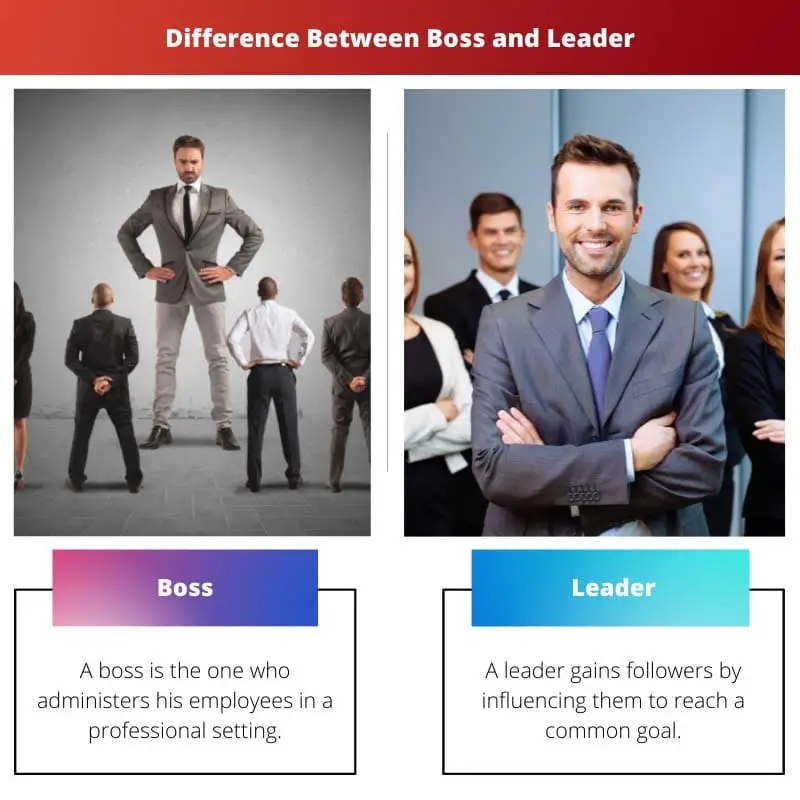A boss often dictates orders, focusing on authority and control. In contrast, a leader inspires and guides, fostering collaboration and growth within their team. While a boss demands compliance, a leader earns respect through empathy, vision, and mentorship.
Key Takeaways
- A boss is a person who has formal authority over employees and is responsible for assigning tasks and managing performance.
- A leader is a person who inspires and motivates others to work towards a common goal and may or may not have formal authority.
- A boss focuses on managing tasks, while a leader focuses on empowering and developing people.
Boss vs Leader
A boss exercises authority and power over subordinates to achieve desired results, tends to focus on tasks and outcomes, and rely on fear and intimidation to get things done. Leaders inspire and motivate their team towards shared goals and prioritize people and relationships.

The leader works towards achieving a goal, but the boss works towards dividing the tasks to be done amongst the people.
A leader has followers, but the boss has employees. A boss administers his employees by instilling fear and discipline within them, but on the other hand, a leader leads by gaining people’s trust and love.
A boss is always administered and rules professionally, but a leader can rule in any sector from anywhere.
The boss admonishes, and it’s a compulsion to follow his direction, but a person can stop following a leader anytime he or she wants to; there isn’t any compulsion.
Comparison Table
| Feature | Boss | Leader |
|---|---|---|
| Focus | Control and authority | Inspiration and motivation |
| Decision-making | Top-down, dictates instructions | Collaborative, involves others |
| Communication | One-way, gives orders | Two-way, open and transparent |
| Motivation | Fear of consequences or expectation of rewards | Shared vision, purpose, and growth |
| Empowerment | Delegates tasks, but not authority | Delegates both tasks and authority |
| Development focus | Individual performance | Team development and growth |
| Relationship with team | Distanced, hierarchical | Close, built on trust and respect |
| Outcome | Tasks completed, short-term goals achieved | Innovation, long-term success, and employee satisfaction |
Who is Boss?
A boss typically refers to an individual in a position of authority within an organization, responsible for overseeing and directing the work of subordinates. The role of a boss involves making decisions, setting goals, and ensuring tasks are completed according to company objectives. While the term “boss” is often associated with management and hierarchy, its connotations can vary based on leadership style and organizational culture.
Characteristics of a Boss
- Authoritarian Approach: Bosses may adopt an authoritarian leadership style, where they exercise control and make decisions without much input from their team members. This top-down approach can lead to a lack of autonomy and creativity among employees.
- Focus on Results: Bosses typically prioritize achieving goals and meeting targets, sometimes at the expense of employee well-being or morale. This emphasis on outcomes can create a high-pressure work environment and may lead to stress and burnout among staff.
- Transactional Relationships: Bosses often view interactions with employees as transactional, primarily concerned with task completion and performance evaluation. This approach may neglect the importance of building meaningful relationships and fostering a supportive work culture.
- Limited Developmental Support: While bosses provide direction and oversight, they may offer limited support for employee development and growth. Opportunities for learning and skill enhancement may be overlooked, hindering long-term career advancement for team members.
Impact of a Boss
- Employee Dissatisfaction: A boss-centric approach can result in disengagement and dissatisfaction among employees, leading to decreased productivity and higher turnover rates.
- Stifled Innovation: The lack of empowerment and collaboration under a boss’s leadership can stifle innovation and hinder the organization’s ability to adapt to change and seize new opportunities.
- Hierarchical Culture: A boss-dominated culture may perpetuate rigid hierarchies and inhibit open communication and feedback channels, impeding organizational agility and responsiveness.
- Limited Leadership Succession: In environments where bosses prioritize their own authority over leadership development, succession planning may be neglected, posing challenges for the continuity and future success of the organization.

Who is Leader?
A leader embodies a person who guides, inspires, and influences others towards achieving common goals. Unlike a boss who relies on authority, a leader earns respect through their actions, vision, and ability to empower those around them. Leadership transcends hierarchical positions and encompasses traits such as empathy, integrity, and vision.
Characteristics of a Leader
- Visionary Outlook: Leaders possess a clear vision of the future and articulate it in a compelling manner, inspiring others to align their efforts towards shared objectives. They convey optimism and enthusiasm, fostering a sense of purpose and direction within their team.
- Empowering Approach: Leaders empower their team members by delegating responsibilities, providing autonomy, and fostering a culture of trust and accountability. They recognize and develop the strengths of individuals, encouraging innovation and creativity.
- Servant Leadership: A hallmark of effective leadership is the willingness to serve others and prioritize their well-being. Leaders lead by example, demonstrating humility, empathy, and a willingness to listen to diverse perspectives. They support the growth and development of their team members, nurturing a collaborative and inclusive environment.
- Continuous Learning: Leaders are committed to personal and professional growth, constantly seeking opportunities to learn and adapt. They embrace feedback and self-reflection, recognizing that leadership is an ongoing journey of improvement. By staying curious and open-minded, leaders inspire a culture of learning and innovation within their organization.
Impact of a Leader
- Employee Engagement: Leaders who prioritize empowerment and collaboration cultivate a sense of ownership and commitment among team members, leading to higher levels of engagement and motivation.
- Innovation and Adaptability: A leader’s visionary outlook and willingness to embrace change enable organizations to innovate and adapt to evolving market dynamics. By fostering a culture of experimentation and learning, leaders encourage risk-taking and creativity.
- Organizational Culture: Leaders play a crucial role in shaping organizational culture, promoting values such as integrity, transparency, and inclusivity. A positive culture built on trust and respect enhances employee satisfaction and loyalty, contributing to long-term success.
- Leadership Pipeline: Effective leaders invest in developing the next generation of leaders, creating a robust leadership pipeline that ensures continuity and succession within the organization. By mentoring and coaching emerging talent, leaders foster a legacy of leadership excellence.

Main Differences Between Boss and Leader
- Approach to Authority:
- Boss: Relies on authority and commands compliance.
- Leader: Earns respect through influence, inspiration, and empowerment.
- Style of Communication:
- Boss: Often directive and top-down, focusing on giving orders.
- Leader: Encourages open communication, listening actively, and fostering dialogue.
- Focus on Results vs. People:
- Boss: Emphasizes achieving results and meeting targets, sometimes at the expense of employee well-being.
- Leader: Balances achieving goals with nurturing and developing the skills and well-being of team members.
- Decision-Making Approach:
- Boss: Makes decisions independently, with limited input from others.
- Leader: Involves team members in decision-making processes, valuing diverse perspectives.
- Relationship with Employees:
- Boss: Often transactional, with limited emphasis on building relationships.
- Leader: Invests in building strong relationships, fostering trust, and supporting the growth and development of team members.
- Long-Term Impact:
- Boss: May create a culture of fear or resentment, leading to high turnover and decreased morale.
- Leader: Cultivates a positive work environment, fostering loyalty, engagement, and long-term success.

- https://books.google.com/books?hl=en&lr=&id=uK_c_iqt1R4C&oi=fnd&pg=PA20&dq=Boss+and+Leader&ots=dj-wcAxiOM&sig=2HLOfNQEv0SbY-DQtUywmh03Tpg
- https://www.jstor.org/stable/41288154

While the article effectively portrays the attributes of a leader, it overlooks the importance of leadership development initiatives and their role in cultivating effective leaders within organizations.
That’s a valid point. Including insights into leadership development strategies would enhance the article’s relevance to talent management and organizational growth.
The distinction drawn between bosses and leaders is crucial. It emphasizes the significance of prioritizing people and relationships in a professional setting, rather than just focusing on tasks and outcomes.
The distinction between administering employees through fear and discipline, and leading by gaining trust and love effectively captures the essence of leadership and its impact on organizational culture.
The article’s emphasis on the significance of a leader’s influence in fostering positive change and inspiring teams resonates with the evolving dynamics of modern workplaces.
The detailed explanation of the roles and responsibilities of bosses and leaders offers valuable insights into the multifaceted nature of effective leadership within organizational contexts.
While the article provides valuable insights into leadership styles and the roles of bosses, it fails to address the challenges of transitioning from a boss to a leader, particularly within hierarchical organizations.
I agree. Exploring the complexities of this transition and navigating the inherent challenges would enhance the article’s depth and applicability to real-world scenarios.
The comparison table provides a clear overview of the contrasting characteristics of bosses and leaders. A valuable resource for understanding the dynamics of authority and motivation in the workplace.
Absolutely, the table effectively summarizes the key differences and highlights the importance of cultivating a positive work environment for long-term success.
This article provides a comprehensive breakdown of the differences between bosses and leaders, highlighting the importance of effective leadership in achieving organizational success. A great read!